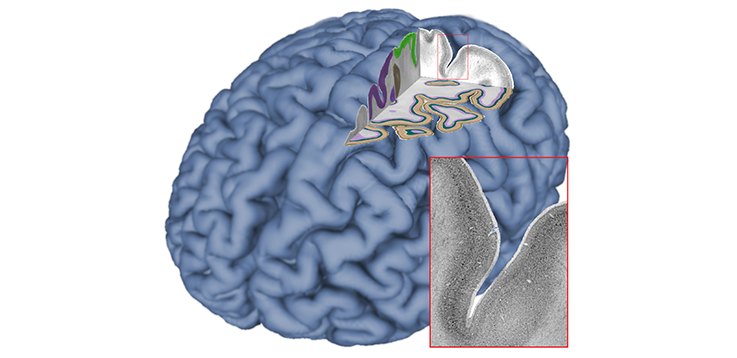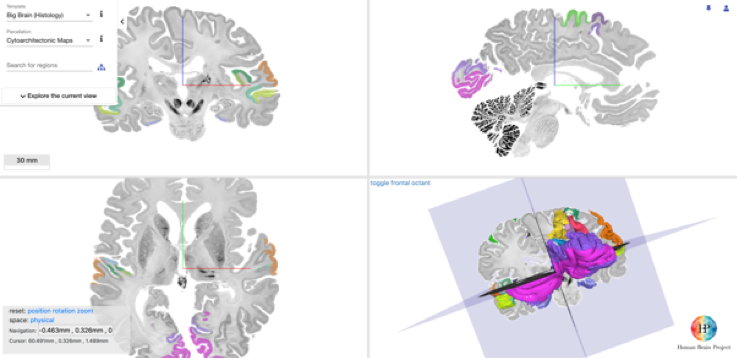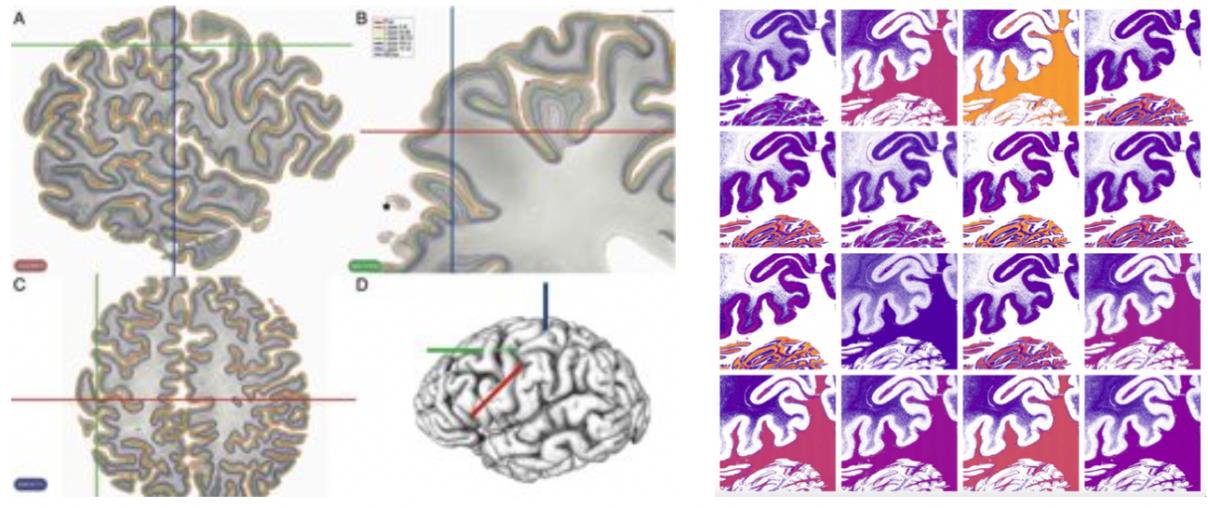New transatlantic lab decodes the brain with AI
25 June 2020
Jülich/Montreal, June 24 2020 – The new German-Canadian lab HIBALL aims to create a microscopic 3D map of functional neuroanatomy at the cellular level with the help of high-performance computing and artificial intelligence. The lab will be officially kicked off this Friday with a virtual satellite event at the annual Organisation of Human Brain Mapping (OHBM) conference. HIBALL is led by longtime collaborators Katrin Amunts, Scientific Research Director of the European Human Brain Project (HBP), and Alan Evans, director of Canada’s Healthy Brains for Healthy Lives initiative. Guest speakers include the German Ambassador to Canada, Sabine Sparwasser, the President of the German Helmholtz Association Otmar Wiestler, Quebec’s Chief Scientist Rémi Quirion and the newly appointed Director General of the HBP and CEO of EBRAINS, Paweł Świeboda. The event will be livestreamed on June 26 at 8:30am EDT / 2:30pm CEST.

The Helmholtz International BigBrain Analytics and Learning Laboratory (HIBALL) is a collaboration between McGill University and Forschungszentrum Jülich to develop next-generation high-resolution human brain models using cutting-edge Machine- and Deep Learning methods and high-performance computing. The lab targets application of this brain model for neuroimaging, brain-inspired AI research and multi-scale brain simulation. HIBALL is based on the high-resolution BigBrain model first published by the Jülich and McGill teams in 2013. Over the next 5 years, the lab will be funded with a total of up to 6 million Euro by the German Helmholtz Association, Forschungszentrum Jülich, and Healthy Brains, Healthy Lives at McGill University.

The BigBrain, openly available with high-resolution maps of cytoarchitectonic areas at https://bigbrain.humanbrainproject.org/ Copyright: Amunts, Schiffer, Dickscheid et al.
The initiative aims at a high level of interoperability with brain initiatives in Canada and Europe, complementing the ongoing work in the HBP and Canadian initiatives in the field of AI and brain health. The scientists draw significantly on HBP-developed infrastructure resources, like the unique functionalities of EBRAINS Multilevel Brain Atlases, and the powerful computing platform FENIX. HIBALL will intensify the collaboration of brain scientists and AI experts to accelerate progress in both fields, and furthers international collaboration between the HBP and the global science community and is set to become an official partnering project.
Fourth BigBrain Workshop: Launch of HIBALL
June 26, Time EDT: 08:30 am – 3 pm; CEST 2:30 – 9pm
Registration necessary to actively participate. Event will also be livestreamed.
Find the programme and registration here
Link for the alternative livestream here
Funding note:
HIBALL is a Helmholtz International Lab, funded by the Helmholtz Association, the Forschungszentrum Jülich, and the Canadian Healthy Brains, Healthy Lives program at McGill University.

About HIBALL and the HBP
Digital 3D atlases of the human brain are basic tools for understanding this organ in its unmatched complexity. Most atlases today offer a resolution in the millimetre range, allowing neuroscientists to study structure-function relationships of areas and large networks. However, they do not incorporate information about thin fibre bundles, cortical layers, columns, microcircuits, or cells. In order to understand brain organisation, spatial scales must be bridged and models at the level of 1 to 20 micrometres have to be developed.
This was started with the BigBrain model, the first human brain model at microscopical resolution. In the European HBP, it became the basis for the most comprehensive atlas of the brain to date, where cellular data are spatially linked with data on other aspects of brain organization.
HIBALL will establish a common platform for high-throughput computing and data analysis, including databasing, visualization, virtualization and big-data exchange between Jülich and McGill. This will build a lasting, trans-continental research platform that will be closely linked to the HBP infrastructure and available for researchers worldwide.
Contacts:

Prof. Katrin Amunts is director of the Institute of Neuroscience and Medicine (INM- 1) at Forschungszentrum Jülich in Germany, as well as the C. and O. Vogt Institute of Brain Research at Heinrich-Heine University Düsseldorf. She is the Scientific Research Director of the Human Brain Project. (Photo FZJ/Sascha Kreklau) Email: k.amunts@fz-juelich.de

Prof. Alan Evans is a James McGill Professor of Neurology and Neurosurgery, Psychiatry and Biomedical Engineering at McGill University since 2009, and a researcher in the McConnell Brain Imaging Centre (BIC) at The Neuro. He is the first Canadian participant in the Human Brain Project and Scientific Director of McGill’s $84 million CFREF project, “Healthy Brains for Healthy Lives.” (Photo: McGill) Email: alan.evans@mcgill.ca
Images / Videos:
 Ultra-high -resolution 3D maps of cytoarchitectural areas in the Big Brain model. Users can navigate in the Big Brain, zoom in to get more details, and see how the brain is parcellated. Copyright: Amunts, Schiffer, Dickscheid et al.
Ultra-high -resolution 3D maps of cytoarchitectural areas in the Big Brain model. Users can navigate in the Big Brain, zoom in to get more details, and see how the brain is parcellated. Copyright: Amunts, Schiffer, Dickscheid et al.
 Left: Cortical layer segmentation in the BigBrain (Wagstyl et al.), visualized in the HBP atlas viewer. Right: A neural network mapping the brain. The different layers of the network capture different tissue properties. Copyright: Amunts, Schiffer, Kiwitz, Dickscheid et al.
Left: Cortical layer segmentation in the BigBrain (Wagstyl et al.), visualized in the HBP atlas viewer. Right: A neural network mapping the brain. The different layers of the network capture different tissue properties. Copyright: Amunts, Schiffer, Kiwitz, Dickscheid et al.
Videos:
(License-free footage available on request)
Selected related publications:
Wagstyl K, Larocque,Guillem S, C Cucurull, JP Lepage Cohen, Bludau S, Palomero-Gallagher N, Lewis LB, Funck T,Spitzer H, Dickscheid T, Fletcher PC, Romero A, Zilles K, Amunts K, Bengio Y, Evans AC: BigBrain 3D atlas of cortical layers: Cortical and laminar thickness gradients diverge in sensory and motor cortices, PLOS Biology, 2020.
Amunts K, Knoll AC, Lippert T, Pennartz CMA, Ryvlin P, Destexhe A, Jirsa VK, D’Angelo E, Bjaalie JG (2019). The Human Brain Project – Synergy between neuroscience, computing, informatics and brain-inspired technologies. Plos Biology, 2019.
Spitzer H, Kiwitz K, Amunts K, Harmeling S, Dickscheid T (2018) Improving Cytoarchitectonic Segmentation of Human Brain Areas with Self-supervised Siamese Networks. MICCAI 2018 link
Amunts K, Ebell C, Muller J, Telefont M, Knoll A, Lippert T. The Human Brain Project: Creating a European Research Infrastructure to Decode the Human Brain. Neuron, 2016.
Amunts K, Zilles K. Architectonic Mapping of the Human Brain beyond Brodmann. Neuron, 2015.
Amunts K, Hawrylycz M, Van Essen D, Van Horn JD, Harel N, Poline JB, De Martino F, Bjaalie JG, Dehaene-Lambertz G, Dehaene S, Valdes-Sosa P, Thirion B, Zilles K, Hill SL, Abrams MB, Tass PA, Vanduffel W, Evans AC, Eickhoff SB (2014) Interoperable atlases of the human brain. Neuroimage, 2014. link
Amunts K, Lepage C, Borgeat L, Mohlberg H, Dickscheid T, Rousseau ME, Bludau S, Bazin PL, Lewis LB, Oros-Peusquens AM, Shah NJ, Lippert T, Zilles K, Evans AC (2013) BigBrain: An ultrahigh-resolution 3D human brain model. Science, 2013. link




